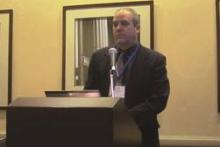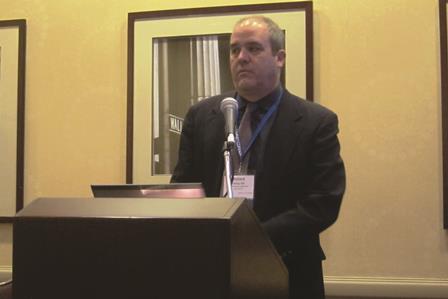User login
NEW YORK - In rural hospitals, family physicians are very likely to deliver babies, even if the facility has at least one obstetrician with admitting privileges, according to survey results of 457 chief executives of rural American hospitals.
The survey also showed that, in southwestern and western states like Texas and Montana, nearly all maternity care–skilled FPs were likely to perform any necessary C-sections, although, across the country, only 63% of FPs are able to deliver cesarean births, Dr. Richard Young said at the annual meeting of the North American Primary Care Research Group.
Just over two-thirds of the respondents said they had dedicated maternity facilities where, on average, 271 babies are born annually, with just over a quarter being delivered by C-section. The hospital executives reported an average ratio of 1.6 obstetricians to every 2.8 maternity-skilled family practitioners, according to Dr. Young, director of research and associate director of the family medicine residency program at John Peters Smith Hospital in Ft. Worth, Tex., which is affiliated with the University of Texas.
Going by the numbers, the average numbers of vaginal and caesarean births a rural hospital required a family doctor to have performed to receive hospital admitting privileges were 40 and 35, respectively.
Because so many respondents either answered the question loosely or not at all, short of having been fellowship trained, “basically, if you claimed you could do this, then ol’ doc Pritchard would watch you do it, and if he said you were good, then you were good,” he concluded.
Practicing midwives in these hospitals were essentially nonexistent.
The findings point to a need for family practice residency programs to include and, in some cases, expand their maternity medicine offerings. “Rural America needs us,” Dr. Young said.
Other data support his imperative. The American Congress of Obstetricians and Gynecologists reports that nearly half of all 3,107 U.S. counties, many of them in rural areas, lack even one ob.gyn. Meanwhile, a 2013 study published in the Journal of Women’s Health and conducted in part by ACOG indicated that, even by modest measures, in 2020 the demand for maternity care specialists would increase 6%, much of it in states with large rural populations, such as Texas, Nevada, and Idaho, yet the number of ob.gyns. entering the field has remained relatively flat since 1980.
In Dr. Young’s survey, the number of acute-care beds corresponded to the maternity-care workload of the family care physicians. Overall, family physicians who offered maternity care tended to figure most prominently in hospitals with 100 beds or fewer, while facilities with 150 beds or more had double the number of OBs as maternity-skilled FPs; however, even then, two-thirds of the FPs still performed their own C-sections.
The study’s accuracy was limited because not all states were represented in the data, and Dr. Young was unsure if he had been able to reach all rural hospital facilities in each state (his initial mailing was to approximately 1,000 facilities). Of the states where hospital executives did respond, three-quarters of the hospitals were critical-access facilities, 60% were nonprofit centers, and just over a quarter were government run. The rest were either for-profit facilities or other types of centers.
Despite what he said were cultural differences from state to state, Dr. Young said that “family doctors continue to provide the majority of maternity care in rural U.S. hospitals.”
The implications of this, he said, were that, even though it was evident from the low threshold for admitting privileges across the facilities surveyed, family medicine residency programs “know what they need to teach … and we’ve got to keep training these doctors how to do obstetrics, including C-sections, because the OBs aren’t going to go to [rural areas] and do it.”
On Twitter @whitneymcknight
NEW YORK - In rural hospitals, family physicians are very likely to deliver babies, even if the facility has at least one obstetrician with admitting privileges, according to survey results of 457 chief executives of rural American hospitals.
The survey also showed that, in southwestern and western states like Texas and Montana, nearly all maternity care–skilled FPs were likely to perform any necessary C-sections, although, across the country, only 63% of FPs are able to deliver cesarean births, Dr. Richard Young said at the annual meeting of the North American Primary Care Research Group.
Just over two-thirds of the respondents said they had dedicated maternity facilities where, on average, 271 babies are born annually, with just over a quarter being delivered by C-section. The hospital executives reported an average ratio of 1.6 obstetricians to every 2.8 maternity-skilled family practitioners, according to Dr. Young, director of research and associate director of the family medicine residency program at John Peters Smith Hospital in Ft. Worth, Tex., which is affiliated with the University of Texas.
Going by the numbers, the average numbers of vaginal and caesarean births a rural hospital required a family doctor to have performed to receive hospital admitting privileges were 40 and 35, respectively.
Because so many respondents either answered the question loosely or not at all, short of having been fellowship trained, “basically, if you claimed you could do this, then ol’ doc Pritchard would watch you do it, and if he said you were good, then you were good,” he concluded.
Practicing midwives in these hospitals were essentially nonexistent.
The findings point to a need for family practice residency programs to include and, in some cases, expand their maternity medicine offerings. “Rural America needs us,” Dr. Young said.
Other data support his imperative. The American Congress of Obstetricians and Gynecologists reports that nearly half of all 3,107 U.S. counties, many of them in rural areas, lack even one ob.gyn. Meanwhile, a 2013 study published in the Journal of Women’s Health and conducted in part by ACOG indicated that, even by modest measures, in 2020 the demand for maternity care specialists would increase 6%, much of it in states with large rural populations, such as Texas, Nevada, and Idaho, yet the number of ob.gyns. entering the field has remained relatively flat since 1980.
In Dr. Young’s survey, the number of acute-care beds corresponded to the maternity-care workload of the family care physicians. Overall, family physicians who offered maternity care tended to figure most prominently in hospitals with 100 beds or fewer, while facilities with 150 beds or more had double the number of OBs as maternity-skilled FPs; however, even then, two-thirds of the FPs still performed their own C-sections.
The study’s accuracy was limited because not all states were represented in the data, and Dr. Young was unsure if he had been able to reach all rural hospital facilities in each state (his initial mailing was to approximately 1,000 facilities). Of the states where hospital executives did respond, three-quarters of the hospitals were critical-access facilities, 60% were nonprofit centers, and just over a quarter were government run. The rest were either for-profit facilities or other types of centers.
Despite what he said were cultural differences from state to state, Dr. Young said that “family doctors continue to provide the majority of maternity care in rural U.S. hospitals.”
The implications of this, he said, were that, even though it was evident from the low threshold for admitting privileges across the facilities surveyed, family medicine residency programs “know what they need to teach … and we’ve got to keep training these doctors how to do obstetrics, including C-sections, because the OBs aren’t going to go to [rural areas] and do it.”
On Twitter @whitneymcknight
NEW YORK - In rural hospitals, family physicians are very likely to deliver babies, even if the facility has at least one obstetrician with admitting privileges, according to survey results of 457 chief executives of rural American hospitals.
The survey also showed that, in southwestern and western states like Texas and Montana, nearly all maternity care–skilled FPs were likely to perform any necessary C-sections, although, across the country, only 63% of FPs are able to deliver cesarean births, Dr. Richard Young said at the annual meeting of the North American Primary Care Research Group.
Just over two-thirds of the respondents said they had dedicated maternity facilities where, on average, 271 babies are born annually, with just over a quarter being delivered by C-section. The hospital executives reported an average ratio of 1.6 obstetricians to every 2.8 maternity-skilled family practitioners, according to Dr. Young, director of research and associate director of the family medicine residency program at John Peters Smith Hospital in Ft. Worth, Tex., which is affiliated with the University of Texas.
Going by the numbers, the average numbers of vaginal and caesarean births a rural hospital required a family doctor to have performed to receive hospital admitting privileges were 40 and 35, respectively.
Because so many respondents either answered the question loosely or not at all, short of having been fellowship trained, “basically, if you claimed you could do this, then ol’ doc Pritchard would watch you do it, and if he said you were good, then you were good,” he concluded.
Practicing midwives in these hospitals were essentially nonexistent.
The findings point to a need for family practice residency programs to include and, in some cases, expand their maternity medicine offerings. “Rural America needs us,” Dr. Young said.
Other data support his imperative. The American Congress of Obstetricians and Gynecologists reports that nearly half of all 3,107 U.S. counties, many of them in rural areas, lack even one ob.gyn. Meanwhile, a 2013 study published in the Journal of Women’s Health and conducted in part by ACOG indicated that, even by modest measures, in 2020 the demand for maternity care specialists would increase 6%, much of it in states with large rural populations, such as Texas, Nevada, and Idaho, yet the number of ob.gyns. entering the field has remained relatively flat since 1980.
In Dr. Young’s survey, the number of acute-care beds corresponded to the maternity-care workload of the family care physicians. Overall, family physicians who offered maternity care tended to figure most prominently in hospitals with 100 beds or fewer, while facilities with 150 beds or more had double the number of OBs as maternity-skilled FPs; however, even then, two-thirds of the FPs still performed their own C-sections.
The study’s accuracy was limited because not all states were represented in the data, and Dr. Young was unsure if he had been able to reach all rural hospital facilities in each state (his initial mailing was to approximately 1,000 facilities). Of the states where hospital executives did respond, three-quarters of the hospitals were critical-access facilities, 60% were nonprofit centers, and just over a quarter were government run. The rest were either for-profit facilities or other types of centers.
Despite what he said were cultural differences from state to state, Dr. Young said that “family doctors continue to provide the majority of maternity care in rural U.S. hospitals.”
The implications of this, he said, were that, even though it was evident from the low threshold for admitting privileges across the facilities surveyed, family medicine residency programs “know what they need to teach … and we’ve got to keep training these doctors how to do obstetrics, including C-sections, because the OBs aren’t going to go to [rural areas] and do it.”
On Twitter @whitneymcknight
Key clinical point: Family physician residency programs must provide extensive maternity care training.
Major finding: Family physicians are twice as likely, on average, to deliver babies in the rural United States, compared with OBs; two-thirds of these FPs perform C-sections.
Data source: Survey of 457 rural American hospital CEOs.
Disclosures: Neither Dr. Young nor his associate, Dr. Kelsey Walker, had any relevant disclosures. The study was made possible by a grant from the Texas Academy of Family Physicians.

